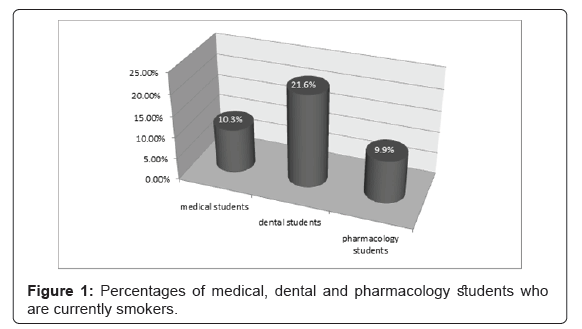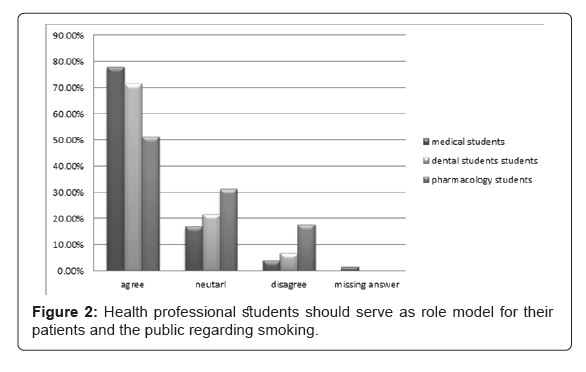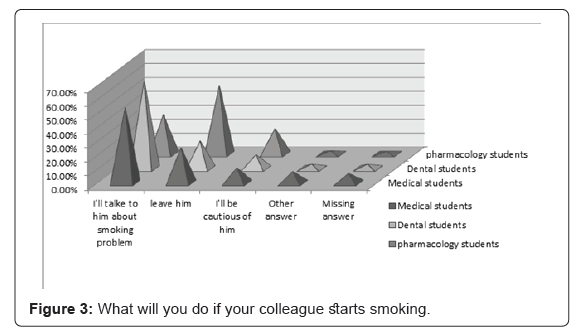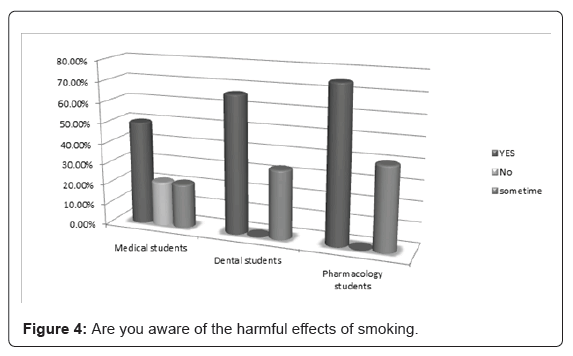Smoking among Medical, Dental and Pharmacology Students: A Prevalence Study
Received: 16-Dec-2020 / Accepted Date: 30-Dec-2020 / Published Date: 07-Jan-2021 DOI: 10.4172/2165-7025.s3.001
Abstract
Medical, Dental and Pharmacology students are supposed to play an important role in smoking prevention and should serve as role models for their patients and the public regarding smoking.
Objectives: The objectives of the present study were to determine the prevalence, knowledge, attitudes and practices among medical, dental and pharmacology students at Qassim University in relation to smoking and perceived role of the colleges in smoking prevention and control.
Materials and methods: The study design was cross-sectional including 375 male dental, medical and pharmacology students present on the day of the survey at Qassim University. An anonymous pilot tested questionnaire was used to collect the data.
Results: 301 questionnaires were returned with an overall response rate of 82.7%. 15 questionnaires were excluded because of incomplete entries leaving behind 286 for final data analysis. Out of 286 students, 12.7% were smoking at the time of the study, 20.4% were ever smokers and 66.9% never smoked during their life time. The percentage of dental students who were currently smoking was higher than the percentages for the other two colleges but the differences amongst the students of the three colleges were not statistically significant. 69.1% of the respondents agreed that health professional students should serve as a role model for their patients and public regarding smoking with a significantly higher percentage of the medical as well as the dental students agreeing to the statement than the pharmacology students (p<0.05). Only 29.0% students were aware of the policy banning smoking in the college. 49.0% of medical students, 63.3% of dental students and 60.5% of pharmacology students did not learn anything about smoking cessation in their colleges. However 64% of the total number of students felt a need for training about smoking cessation techniques in the college. A significant number of smokers were smoking to relieve stress and as a source of enjoyment during their leisure.
Conclusion: The majority of medical and dental students and almost half of the pharmacology students held positive attitudes towards smoking prevention. The colleges’ role in the prevention and control of smoking turned out to be inadequate.
Keywords: Health professional students; Medical; Dental; Pharmacology; Smoking; Colleges
Introduction
Tobacco is the second major cause of death worldwide [1]. There are more than 1 billion smokers in the world and 5 million deaths occur due to tobacco habit each year [2]. If the present consumption pattern continues, the number of deaths will increase to 10 million by the year 2030, 70% of which will occur in the developing countries [3]. Therefore the prevention and control of smoking has become a global concern. Several studies have shown that smoking prevalence is high particularly among adult males in Saudi Arabia [4-8]. In spite of having a health warning on every packet of cigarettes and anti-smoking clinics distributed all over the Kingdom, smoking in Saudi Arabia is increasing rapidly, especially among the young people. A significant contributory factor to this increasing trend is aggressive marketing by tobacco companies [9].
The students related to health profession are expected to play an important role in smoking prevention and control in future. The health professionals ought to be role models for their patients. The code of practice proposed by WHO (World Health Organization) in 2004, encourages health professionals to provide their patients with information about the health consequences of smoking, help their smoking patients to quit and act as a role model to promote tobacco free life style [10]. There is evidence to show that a very brief advice lasting less than three minutes given in a good manner by a health professional will help about 2% of smokers to successfully stop smoking[11].Therefore it is very important to involve health professionals in any aspects of smoking control in the society. In an attempt to improve the participation of health-care providers in smoking cessation efforts, the National Cancer Institute recommended including tobacco-treatment education in the curricula of all US medical schools by 1995 [12].
Some significant barriers to anti-tobacco counselling by health professionals have been identified that include self-use of tobacco and lack of training in patients’ counselling about quitting tobacco use [13].
The objectives of the present study were to determine the prevalence of smoking among medical, dental and pharmacology students at Qassim University, their knowledge, attitudes, practices and perceived role of the colleges in smoking prevention and control.
Materials and Methods
The study design was cross-sectional including 375 male dental,medical and pharmacology students present on the day of the survey at Qassim University during October-December 2009. An anonymous pilot tested questionnaire with 20 questions written in English was used to collect the data. The questionnaires were distributed during lectures and were taken back by designated students in each class.
Smoking status was classified for the sake of data analysis as [14]:
• Currently smoker: those who are smoking at present.
• Ever smoker: those who had ever in their life time even for once.
• Never smoker: those who had never smoked during life time.
Statistical analysis of dataThe data was coded and then entered in Excel 2007 program. It was then transferred to SPSS version-16 for analysis. Chi-square test was used to make a comparison among the students of the three colleges wherever needed.
Results
A total of 375 questionnaires were distributed to all the male students in the College of Medicine, College of Dentistry and College of Pharmacy at Qassim University present on the day of the survey. 301 questionnaires were returned with an overall response rate of 82.7%. 15 questionnaires were excluded because of incomplete entries leaving behind 286 for final data analysis (Table 1). The total number of students in the three colleges was 320, 75 and 160 respectively.
| Health professionals’ colleges | No. of questionnaires distributed | No. of questionnaires returned | Response rate % | No.of excluded questionnaires | No.of questionnaires analyzed |
|---|---|---|---|---|---|
| College of Medicine | 200 | 149 | 74.5 | 4 | 145 |
| College of Dentistry | 75 | 65 | 86.6 | 5 | 60 |
| College of Pharmacy | 100 | 87 | 87 | 6 | 81 |
| Total | 375 | 301 | 82.7 | 15 | 286 |
Table 1: Distribution of questionnaires.
The majority of students (overall 88.1%) belonged to the age group 20-25 years in all three colleges. Figure 1 shows the relative prevalence of smoking among the students of the three colleges.
Out of 284 students who answered to the questions about smoking status, 12.7% were smoking at the time of the study, 20.4% were ever smokers and 66.9% never smoked during their life time. The percentage of dental students who were currently smoking was higher than the percentages for the other two colleges but the differences amongst the students of the three colleges were not statistically significant at an α level of <0.05. The same was true for the category of ever smokers in the college of pharmacology. On the other hand, a lower percentage of students in this college never smoked (Table 2).
| Smoker status | Medical students | Dental students | Pharmacology students | Total | ||||
|---|---|---|---|---|---|---|---|---|
| No. | (%) | No. | (%) | No. | (%) | No. | (%) | |
| Currently smoking | 15 | 0.104 | 13 | 0.22 | 8 | 0.099 | 36 | 0.127 |
| Ever smoked | 26 | 0.18 | 4 | 0.068 | 28 | 0.345 | 58 | 0.204 |
| Never smoked | 103 | 0.716 | 42 | 0.712 | 45 | 0.556 | 190 | 0.669 |
Table 2: prevalence of smoking among Medical, Dental, and Pharmacology students*.
Attitudes of health professional students regarding smoking
When asked about their perception towards problem of smoking amongst the health professional students, 69.2% agreed that there is a problem if health professional student’s smoke while 19.2% were found to be neutral about these statement and 11.2% students did not consider it a problem. A significantly higher percentage of students in the medical and dental groups disagreed to the statement that ‘there is no problem if students related to health profession smoke’ than the pharmacology students (p<0.05). 69.1% agreed that health professional students should serve as a role model for their patients and public regarding smoking. A significantly higher percentage of the medical as well as the dental students thought that they should be serving as a role model for their patients and public than the pharmacology students (p<0.05) (Figure 2).
Colleges’ role in smoking prevention
Students were asked four questions about the role played by the colleges in the prevention of smoking. In the first question the students were asked whether their respective colleges have a role in preventing the smoking habit. 41.3% students said their colleges don't have any role against students’ smoking. Only 29.0% students were aware of the policy banning smoking in the college premises and clinics. 49.0% of medical students, 63.3% of dental students and 60.5% of pharmacology students did not learn anything about smoking cessation in their colleges. The fourth question was to seek students’ opinion about getting specific training on smoking cessation techniques in the college. 64% of the total number of students agreed with the suggestion. The students of the three colleges showed no statistically significant difference regarding the colleges’ role in smoking prevention (Table 3).
| Medical students | Dental students | Pharmacology students | Total | |
|---|---|---|---|---|
| My college have a role in preventing the smoking habit | 0.331 | 0.367 | 0.346 | 0.343 |
| My college have a policy banning smoking in the college premises and clinics | 0.345 | 0.3 | 0.185 | 0.29 |
| Learned about smoking cessation in the college | 0.497 | 0.35 | 0.383 | 0.434 |
| Should have training on smoking cessation techniques in the college | 0.666 | 0.7 | 0.543 | 0.64 |
Table 3: Colleges ‘role in smoking prevention.
In response to a question about the caring role of the health professional students in the cessation of smoking in their smoker colleagues, about half of the respondents were found to be willing to discuss the problems related to smoking with such friends while 31% would be terminating their relationship with such students and another 12.9% will become cautious in their relations with smoker colleagues. A small minority (5.6%) answered like ‘I don't care’, ‘will call his dad’, ‘I don't know’, ‘it depends on his health condition’ (Figure 3).
The smokers (n=36) were further asked ten questions about their smoking habit. Three of the smokers did not respond to these questions.
Starting age for smoking
The results showed that the majority of the smokers (51.5%) started smoking between the age of 16-20 years and 36.3% started their smoking habit after this age. Only one student started before the age of 16 years and another two after joining the college. The remaining one did not respond to this question.
Reasons for smoking
More than one third of smokers in the medical (35.7%) and dental (33.3%) groups; and around one third of those in the pharmacology group (28.6%) reported that smoking was helpful in reliving their stress. A significantly higher percentage of dental (41.7%) and pharmacology smokers (42.9%) used to enjoy smoking during their leisure than the percentage of smokers (14.3%) in the medical group (p<0.05).
The perceived effect of the smoking habit on patients’ dealing
25% of health professional student smokers seemed to be concerned about their smoking habit while dealing with their patients. 30.5% of the smokers claimed that health professional students should not smoke. 69.4% of the smokers felt reluctant while smoking in front of their patients while 19.4% did not mind it.
The perceived effect of smoking status on patient’s education
About 72.2% of the health professional student smokers were determined to educate their patients about smoking despite their self- smoking. Majority of the smokers (61%) thought that their patients would accept their recommendations.
Knowledge regarding harmful effects of smoking
Figure 4 shows the distribution of medical, dental and pharmacology students according to their awareness of the harmful effects of smoking. 57.6 % of the total number of smokers claimed to be knowledgeable about the harmful effects of smoking with a comparatively higher percentage of pharmacology students.
30.5% of the smokers never received any advice from the college staff related to smoking cessation while 27.7% of them were given some advice. 25% of smokers reported that the staff did not know about their habit. In response to a question about the most common place where health professional students smoked in the colleges, more than half of smoker students (55.5%) reported that they smoked in the park of the college and 22.2% smoked in a public place. None of the students reported smoking inside the college building.
Discussion
In this study the prevalence rates of smoking in the Medical, Dental and Pharmacy colleges at Qassim University are 10.3%, 21.7% and 9.9% respectively, with a higher prevalence among dental students. It was heartening to know that the prevalence among health professional students was less than that in the general population of Saudi Arabia [4-8].
The prevalence of smoking among the medical students in the present study was found to be lower than that among the medical students in King Saud University in Riyadh (33%) and Abha (13.6%) [15,16]. It was also significantly lower than the prevalence in the neighbouring countries such as Bahrain (27.5%), Jordan (26.3%) and Syria (15.8%) [17-19].
This study was the first one to determine the prevalence of smoking among dental and pharmacology students in Saudi Arabia at Qassim University. A search on the internet failed to reveal any study about the prevalence of smoking among dental and pharmacology students in Saudi Arabia.
Dental students in this study had a lower prevalence of smoking as compared to their counterparts in Argentina (38.3 %) [20]. In a study of 101 practicing dentists in Riyadh, Saudi Arabia, smoking prevalence turned out to be 14.2% [21], which is much lower than the smoking prevalence among dental students in the study under discussion. On the contrary the smoking prevalence among medical students has been shown to be lower than that of medical doctors in many countries [22].
Majority of health professional students in this study reported that they should serve as a role model for their patients and public regarding smoking. This finding is similar to other studies carried out in India, United States, Indonesia and Jordan [17,23-25]. In some studies more than 90% of medical students believed in taking a more active role in providing smoking cessation for patients and believed that doctors ought to set a good example to patients and other health workers by not smoking [26].
The data of this study revealed that most of the health professional students in all the three groups had good perceived knowledge about the harmful effects of smoking. This finding was similar to those reported by many other studies [16,17].
Although dental students had a higher prevalence of smoking than the other two groups involved in the study, the attitudes of the dental as well as medical students towards smoking and its prevention were more positive than the pharmacology students. The majority of medical and dental students felt a need for training in smoking cessation techniques. This is important as the medical and dental students usually have greater contact time with their patients than the pharmacology students.
Some caution must be exercised while generalizing the findings of the study due to certain limitations like the inclusion of students of only one university in the kingdom, missing data for some students as only those who were present on the day of the survey were included in the study. Also the number of smokers in the study groups was too small to provide any conclusive results.
Conclusions
1. The prevalence of smoking amongst the study groups was low as compared to the natives of Saudi Arabia as well as to that among the students of the neighbouring countries.
2. The majority of medical and dental students and almost half of the pharmacology students held positive attitudes towards smoking and its prevention.
3. The colleges’ role in the prevention and control of smoking turned out to be inadequate.
4. The colleges either did not have a policy imposing ban on smoking or the students were not aware of it.
5. About one third of smokers thought that smoking was having a stress-relieving effect in their case. A substantial number of smokers in dental and pharmacology groups used to enjoy smoking during their leisure.
Recommendations
1. All colleges must be having an anti-smoking policy that must be made public to all the students by adopting appropriate strategies.
2. The colleges must show serious commitment and make concerted efforts in implementing this policy by involving all the stakeholders.
3. Education about smoking must be included in the curriculum right from first year and anti-smoking messages must be reinforced at regular intervals during all academic years.
4. The students should be given training about smoking cessation and counselling techniques and must be motivated to play their role in patients’ education regarding smoking.
5. Health promoting activities must be organized in colleges to provide opportunities to the students to relieve their stress and pass their leisure.
Acknowledgment
The author owes special thanks to Dr. Mohammad Almohimeed, the Dean of College of Dentistry for encouraging to conduct this research, Dr. Abdulhaleem for supervising the research, Prof. abdulwahab Samaha for editing the manuscript, Mosa Alrsheedi ,Sami H Alrsheedi, Sami M Alrsheedi, Yasser Alyahya, Khaled Alrsheedi, Khaled Alotaiby and Ahamad Alasmry for distributing the questionnaires and collecting them back.
References
- Tjandra YA (2006) Rokok di Indonesia. (Smoking in Indonesia); Jakarta 11: 56-65.
- WHO: (2002) The World Health Report: Reducing Risks, Promoting Healthy Life. Geneva.
- Saudi Arabian national cancer registry (1994) First report, Cancer incidence in Saudi Arabia; Riyadh: National Cancer Registry.
- Saeed AA, Khoja TA, Khan SB (1996) Smoking behaviour and attitudes among adult Saudi nationals in Riyadh City, Saudi Arabia. Tob Control 5: 215-219.
- Al-Nozha MM, Arafah MR, Al-Mazrou YY (2004) Coronary artery disease in Saudi Arabia. Saudi Med J 25: 1165-1171.
- Jarallah JS, Al-Rubeaan KA, Al-Nuaim AR, Al-Ruhaily AA, Kalantan KA (1999) Prevalence and determinants of smoking in three regions of Saudi Arabia; Tobacco Control 8: 53-56.
- Saima S, Ogbeide, Al Khalifa (2001) Smoking in a Saudi Community; Prevalance, Influencing Factors, and Risk Perception. Fam Med 33: 367-370.
- Anonymous (1983) Health or smoking (editorial). Br Med J 287: 1570-1571.
- The GTTS Collaborative Group (2006) Tobacco use and cessation counselling: Global Health Professionals Survey Pilot Study 10 countries, 2005. Tobacco Control 15: 31-34.
- Watt R, Robinson M (1999) Helping smokers to stop: A guide for the dental team; Health Education Authority: London.
- Fiore MC, Epps RP, Manley MW (1994) The National Cancer Institute Expert Panel on Applications of Smoking Cessation Research for Medical Schools; A missed opportunity: teaching medical students to help their patients successfully quit smoking. JAMA 271: 624-626.
- WHO, CDC (2005) Dental students and Tobacco Use in India. A pilot study for the Global Health Professional Survey.
- Singh GD, Sinha DN (2005) Prevalence and correlates of Tobacco use among 10-12 year old school students in Patna district, Bihar, India. Indian Pediatrics 42: 805-810.
- Smith DR, Leggat PA (2007) An international review of tobacco smoking among medical students. J Postgrad Med 53: 55-62.
- Abolfotouh MA, Abdel Aziz M, Alakija W (1998) Smoking habits of King Saud University students in Abha, Saudi Arabia. Ann Saudi Med 18:212-216.
- Merrill JR, Madanat HN, Cox E, Merrill JM (2009) Perceived effectiveness of counselling patients about smoking among medical students in Amman, Jordan. East Mediterr Health J 15:1180-1191.
- Hamadeh RR (1994) Smoking habits of medical students  in Bahrain; J Smok Rel Dis 5: 189-195.
- Almerie MQ (2008) Cigarettes and waterpipe smoking among medical students in Syria; Int J Tuberc Lung Dis 12: 1085-1091.
- Centers for Disease Control and Prevention (CDC) (2005) Tobacco use and cessation counseling-global health professionals survey pilot study, 10 countries. MMWR Morb Mortal Wkly Rep 54: 505-509.
- Al-Qhtani D, Al-Qahtani M, Al-Otaibi O, Al-Mobeeriek A (2007) Dentists's attitudes and practice regarding smoking cessation intervention and prevention in Riyadh; Saudi Arabia. Intern seminar presented.
- Crofton JW, Fréour PP, Tessier JF (1994) Medical education on tobacco: implications of a worldwide survey. Tobacco and Health Committee of the International Union against Tuberculosis and Lung Disease (IUATLD).Med Educ 28: 187-196.
- Harini PM, Sham SB, Sundeep HK (2008) Prevalence, Knowledge and Attitude of Tobacco Use among Health Professionals In Mangalore City, Karnataka. JOHCD 2.
- Patkar AA, Hill K, Batra V, Vergare MJ, Leone FT (2003) A comparison of smoking habits among medical and nursing students. Chest 12: 1415-1420.
- Tjandra YA, Zaura KA (2008) Global Health Professions Student Survey (GHPSS) among Dental Students, Indonesia 2007-2008.
- Richmond RL, Kehoe L (1997) Smoking behavior and attitudes among Australian medical students. Med Educ 31: 169-176.
Citation: Alrashdi M (2021) Smoking among Medical, Dental and Pharmacology Students: A Prevalence Study. J Oral Hyg Health S3:001. DOI: 10.4172/2165-7025.s3.001
Copyright: © 2021 Alrashdi M. This is an open-access article distributed under the terms of the Creative Commons Attribution License, which permits unrestricted use, distribution, and reproduction in any medium, provided the original author and source are credited.
Share This Article
Recommended Journals
Open Access Journals
Article Tools
Article Usage
- Total views: 1853
- [From(publication date): 0-2021 - May 01, 2025]
- Breakdown by view type
- HTML page views: 1121
- PDF downloads: 732




